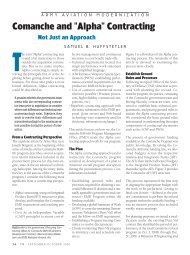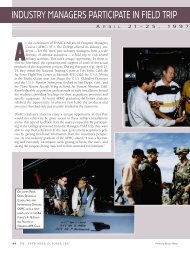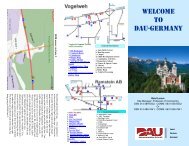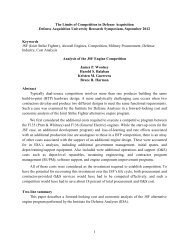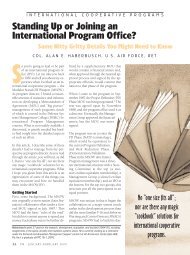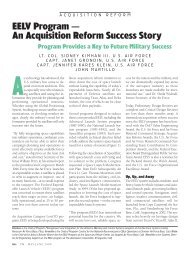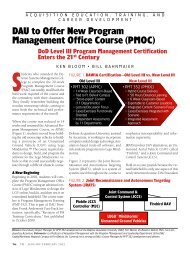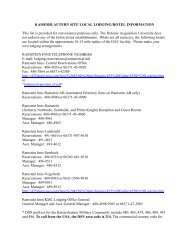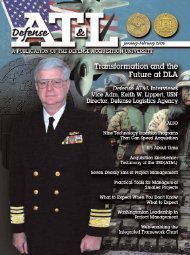Defense ARJ - Defense Acquisition University
Defense ARJ - Defense Acquisition University
Defense ARJ - Defense Acquisition University
You also want an ePaper? Increase the reach of your titles
YUMPU automatically turns print PDFs into web optimized ePapers that Google loves.
<strong>Defense</strong> <strong>Acquisition</strong> Review Journal<br />
tAble 13. length of proJeCt developMent and proJeCt<br />
perforManCe<br />
here. The projects divided cleanly between 7 that took 37 months or less, and 6 that<br />
took 48 months or more. When the frequency of systems requirements changes is<br />
considered, longer duration clearly allows more time for changing external conditions<br />
and priorities to lead to changes in systems requirements. Four of seven of the shorter<br />
projects never experienced any changes in requirements, and the remaining three only<br />
experienced minimal changes. None of the six projects that ran four years or longer<br />
avoided requirements changes, two saw changes once or twice, and four experienced<br />
either several or many changes. The pattern is quite strong and statistically significant<br />
despite the limited number of cases (top, Table 12).<br />
Given that longer schedules increase the risk of encountering instabilities, it<br />
is then not surprising that project duration is also negatively related to achieving<br />
desirable project outcomes. For example (bottom, Table 12), one of the strongest<br />
relationships between development duration and project outcomes is found for how<br />
the system performed in the field. Six of the seven systems developed in (about) three<br />
years or less met or exceeded expectations when they were deployed in DESERT<br />
STORM, compared to only two of six of the longer projects. The effect on all six<br />
outcome questions is seen in Table 13 with the projects requiring longer development<br />
time averaging success on only two outcomes, where the shorter development<br />
projects had an average 4.7 successful outcomes.<br />
The sensitivity of this central conclusion to project complexity was examined<br />
using a measure of relative complexity (Table 1) developed for this purpose. More<br />
complex projects often require longer development cycles and are more likely to<br />
experience funding difficulties. However, complexity is much more weakly related<br />
with staffing turnover than is project duration, and differences in complexity are not<br />
found to be at all related with changes of TRADOC personnel or changes in systems<br />
requirements. Complexity is also not related to testing quality and timeliness; both<br />
of these factors are strongly (and positively) correlated with outcomes. Importantly,<br />
duration alone is more strongly related than complexity to the number of successful<br />
outcomes. Whether or not complexity plays a role, project duration has a strong effect<br />
on outcomes independent of the influence of complexity.<br />
The evidence here is that time is not an ally of systems development. The passage<br />
of time and the inevitable intrusion of new knowledge open the door to new<br />
pressures. Financial uncertainty is created in part by the need for resources for newer<br />
projects, often leading to staffing doubts about the current program and/or the appearance<br />
of new opportunities where key personnel are also needed. Or, simple<br />
career progression incentives lead people after time to move on, taking knowledge<br />
128<br />
Average number of successful outcomes<br />
Project duration?<br />
Three years<br />
or less<br />
Four years<br />
or more<br />
Signif. at<br />
4.71 2.00 .001




